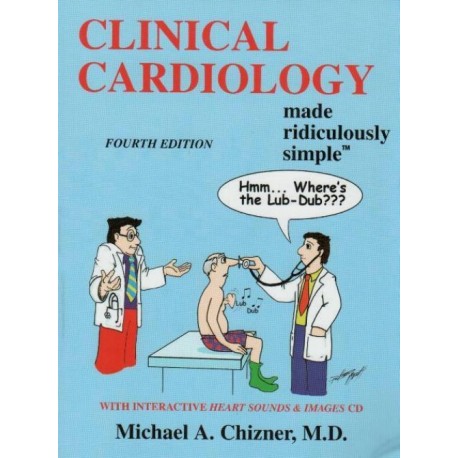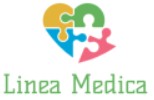Sin productos
Precios están sin IVA
Producto añadido correctamente a su carrito de compras
Hay 0 artículos en su carrito. Hay 1 artículo en su carrito.
¡Producto agregado con éxito a la cotización!
 Ver más grande
Ver más grande
En Existencia
Clinical Cardiology Made Ridiculously Simple
9781935660040
Autor : Chizner
Materia : Cardiología
Editorial : MedMaster
Año : 2012
Edición : 4th
Idioma : Inglés
ISBN : 9781935660040
Paginas : 355
Encuadernación : Pasta blanda
Tipo de Impresión : B/N
Más información
DESCRIPCIÓN GENERAL:
A clear, concise, highly practical and enjoyable overview of all of clinically relevant cardiology. History, physical, ECG (ECG interpretation taught in just 40 pages), radiology, noninvasive and invasive diagnostic tests, and therapy (both pharmacologic and nonpharmacologic). Includes interactive CD-ROM (Win/Mac) with heart sounds, ECG interpretation, chest x-rays, echocardiography and quiz. For medical students, house officers, cardiac fellows, practicing physicians, and other health care professionals
DIRIGIDO A:
Médicos Cardiólogos
CONTENIDO:
PART I. THE FIVE-FINGER APPROACH TO CARDIAC DIAGNOSISCHAPTER 1. THE CARDIAC HISTORY
Chest Pain or Discomfort
Coronary Artery Disease (CAD)
Stable Angina Pectoris, Unstable Angina, and Acute Myocardial Infarction
Pertinent Past Medical History and/or Risk Factors for CAD
Chest Pain in Other Cardiovascular Conditions
Pericarditis
Aortic Dissection
Mitral Valve Prolapse
Left Ventricular Outflow Tract Obstruction (e.g., Valvular Aortic Stenosis, Hypertrophic Cardiomyopathy)
Pulmonary Hypertension
Shortness of Breath
Fatigue and Weakness
Cough and Hemoptysis
Palpitations
Dizziness, Near-Syncope, and Syncope
Other Symptoms
Fever, Chills, and Sweats
Gastrointestinal Symptoms
Embolic Symptoms
Intermittent Claudication
Changes in WeightCHAPTER 2. THE CARDIAC PHYSICAL EXAM
Cardiac Anatomy and Physiology
INSPECTION
-General Appearance
-Cutaneous Manifestations (Skin Color, Temperature, Texture)
-Voice
-Jugular Venous Pressure (JVP) and Pulse
-Estimating JVP
-Abdominojugular Test
-Abnormalities of the Venous Wave Form
PALPATION
-Blood Pressure and Arterial Pulse
-Abnormalities of Blood Pressure
-Abnormalities of Arterial Pulse
-Precordial Movements and Palpation
AUSCULTATION
-The Cardiac Cycle
-Use of the Stethoscope
-Dynamic Auscultation
-Heart Sounds: Normal and Abnormal
-First and Second heart sounds (S1 and S2)
-Auscultation of S1 ("Lub")
-Loud S1
-Faint S1
-Variable Intensity of S1
-Auscultation of S2 ("Dub")
-Intensity and Splitting of S2
-Sounds in Systole
-Ejection Sounds and Systolic Clicks
-Sounds in Diastole
-Third and Fourth Heart Sounds (S3 and S4)
-Other Diastolic Sounds
-Heart Murmurs: Systolic, Diastolic, and Continuous
-Systolic Murmurs -- Innocent vs Significant ("Guilty")
-Early-mid Systolic (Ejection) Murmurs
-Innocent Murmurs
-Aortic Stenosis
-Pulmonic Stenosis
-Hypertrophic Obstructive Cardiomyopathy
-Atrial Septal Defect
-Holosystolic Murmurs
-Mitral Regurgitation
-Tricuspid Regurgitation
-Ventricular Septal Defect
-Late Systolic Murmurs
-Mitral Valve Prolapse
-Diastolic Murmurs
-Early Diastolic Murmurs
-Aortic Regurgitation
-Pulmonic Regurgitation
-Middiastolic and Presystolic Murmurs
-Mitral Stenosis
-Tricuspid Stenosis
-Continuous Murmurs
-Patent Ductus Arteriosus
-Jugular Venous Hum
-Coronary Arteriovenous Fistula
-Pulmonary Arteriovenous Fistula
-Ruptured Sinus of Valsalva Aneurysm
-Miscellaneous
-Pericardial Friction RubsCHAPTER 3. ELECTROCARDIOGRAM
Basic Electrocardiography
Cardiac Electrical Activity and the Electrocardiogram (ECG)
Standard ECG Leads
Approach to ECG Interpretation
Rate and Rhythm
The P Wave
The QRS
The T Wave
The U Wave
The PR Interval
The ST Segment
The QT Interval
QRS Axis
Major ECG Abnormalities: Diagnostic Clues and Clinical Correlations
Myocardial Ischemia and Infarction
Cardiac Chamber Enlargement and Hypertrophy
Miscellaneous Patterns
Arrhythmias and Conduction DisturbancesCHAPTER 4. CHEST X-RAY
The Cardiovascular Silhouette, Cardiac Chambers and the Aorta
The Pulmonary Vasculature
The Lung Fields
Thoracic Cage Abnormalities
CHAPTER 5. CARDIAC DIAGNOSTIC LABORATORY TESTS
Blood Tests
Routine Chemistries
Cardiac Enzymes
Specialized Non-invasive Tests
Transthoracic M-Mode and Two Dimensional Color-Flow Doppler
Echocardiography
Transesophageal Echocardiography
Ambulatory Electrocardiography; Holter Monitoring and Transtelephonic
ECG/Event Recording
Signal Averaged Electrocardiography
Tilt-Table Testing
Exercise and Pharmacologic Stress Testing, including Nuclear and
Echocardiographic Imaging
Radionuclide Studies
Electron Beam Computed Tomography
Specialized Invasive Techniques
Cardiac Catheterization: Coronary Angiography and Left Ventriculography
Electrophysiologic Studies (EPS)
Summary: Non-invasive and Invasive Test Indications and ApplicationsPART II. CARDIOVASCULAR THERAPYCHAPTER 6. GENERAL CONSIDERATIONS IN CARDIOVASCULAR THERAPYCHAPTER 7. CARDIAC DRUGS
Beta blockers
Calcium Channel Blockers
Nitrates
Angiotensin-Converting Enzyme (ACE) Inhibitors
Angiotensin Receptor Blockers (ARBs)
Inotropic Agents
Digitalis Glycosides
Sympathomimetic Amines
Phosphodiesterase Inhibitors
Diuretics
Thiazides
Loop Diuretics
Potassium Sparing Diuretics
Antiplatelet Agents
Aspirin
Thienopyridines
Glycoprotein II b/III a Receptor Inhibitors
Thrombolytics and Anticoagulants
Thrombolytic Agents
Unfractionated and Low Molecular Weight Heparin
Warfarin (Coumadin)
Lipid Controlling Agents
HMG CoA Reductase Inhibitors (Statins)
Nicotinic Acid (Niacin)
Bile Acid Sequestrants (Resins)
Fibric Acid Derivatives (Fibrates)
Other Agents (e.g., Ezetimibe)
Antiarrhythmic Agents
-Class I Agents
-Class II Agents
-Class III Agents
-Class IV Agents
-Other Agents (e.g., Digitalis, Adenosine)CHAPTER 8. CARDIAC NONPHARMACOLOGIC AND INTERVENTIONAL TECHNIQUES
Percutaneous Coronary Intervention (PCI): Percutaneous Transluminal Coronary
Angioplasty (PTCA) and Stenting
Transluminal Balloon Valvuloplasty
Radiofrequency Catheter Ablation
Electrical Cardioversion and DefibrillationCHAPTER 9. CARDIAC DEVICE THERAPY
Cardiac Pacemakers
Implantable Cardioverter DefibrillatorCHAPTER 10. CARDIAC SURGERY
Coronary Artery Bypass Grafting
Valvular Repair and/or Replacement
Cardiac TransplantationPART III. PUTTING IT ALL TOGETHERCHAPTER 11. APPROACH TO THE PATIENT WITH CORONARY ARTERY DISEASE
Angina Pectoris
Clinical Recognition of Stable Angina Pectoris
Clinical Recognition of Unstable Angina
Management of Stable Angina Pectoris
Management of Unstable Angina
Acute Myocardial Infarction (MI)
Clinical Recognition of Acute MI
Management of Acute MI
Complications of Acute MI
Electrical Complications of Acute MI
Ventricular Arrhythmias
Supraventricular Arrhythmias
Bradyarrhythmias and Conduction Disturbances
Mechanical Complications of Acute MI
Left Ventricular (LV) Systolic Dysfunction
Acute Ventricular Septal Defect and Papillary Muscle Rupture
Right Ventricular Infarction
Left Ventricular Aneurysm
LV Free Wall Rupture and Pseudoaneurysm
Pericarditis
Secondary Prevention: Pharmacologic Therapy, Risk Factor Modification and
Cardiac RehabilitationCHAPTER 12. APPROACH TO THE PATIENT WITH HEART FAILURE
Etiology and Pathophysiology
Left Ventricular Systolic Dysfunction
Dilated Cardiomyopathy
Left Ventricular Diastolic Dysfunction
Treatment of Chronic Heart Failure
Treatment of Acute Pulmonary EdemaCHAPTER 13. APPROACH TO THE PATIENT WITH SYSTEMIC ARTERIAL HYERTENSION
Primary and Secondary Forms of Hypertension
Clinical Manifestations of Hypertension
Therapy of Hypertension
CHAPTER 14. APPROACH TO THE PATIENT WITH DYSLIPIDEMIA
Pathogenesis of Atherosclerosis
Therapeutic ConsiderationsCHAPTER 15. APPROACH TO THE PATIENT WITH VALVULAR HEART DISEASE
Aortic Stenosis (AS)
Clinical Recognition of AS
Management of AS
Aortic Regurgitation (AR)
Chronic AR
Clinical Recognition of Chronic AR
Acute AR
Clinical Recognition of Acute AR
Management of Chronic and Acute AR
Mitral Regurgitation (MR)
Chronic MR
Clinical Recognition of Chronic MR
Management of Chronic MR
Acute MR
Clinical Recognition and Management of Acute MR
Mitral Valve Prolapse (MVP)
Clinical Recognition of MVP
Management of MVP
Rheumatic Mitral Stenosis (MS)
Clinical Recognition of Rheumatic MS
Management of Rheumatic MS
Tricuspid Regurgitation (TR)
Clinical Recognition of TR
Management of TRCHAPTER 16. APPROACH TO THE PATIENT WITH HYPERTROPHIC CARDIOMYOPATHY
Clinical Recognition of Hypertrophic Obstructive Cardiomyopathy (HOCM)
Treatment Options for HOCM
Risk of Sudden DeathCHAPTER 17. APPROACH TO THE PATIENT WITH INFECTIVE ENDOCARDITIS
Etiology and Risk Factors
Clinical Presentation of Infective Endocarditis
Therapy of Infective EndocarditisCHAPTER 18. APPROACH TO THE PATIENT WITH AORTIC DISSECTION
Classification and Pathogenesis
Clinical Manifestations of Aortic Dissection
Medical and Surgical Considerations in Aortic DissectionCHAPTER 19. APPROACH TO THE PATIENT WITH PERICARDIAL DISEASE
Acute Pericarditis
Cardiac Tamponade
Constrictive PericarditisCHAPTER 20. APPROACH TO THE PATIENT WITH PULMONARY HYPERTENSION
Pathophysiologic Mechanisms
Clinical Recognition of Primary Pulmonary Hypertension
Management of Pulmonary HypertensionCHAPTER 21. APPROACH TO THE PATIENT WITH A HEART MURMUR
When to Order a Doppler-EchoCHAPTER 22. APPROACH TO THE PATIENT WITH CARDIAC ARRHYTHMIAS AND CONDUCTION DISTURBANCES
General Considerations
Atrial Fibrillation
Supraventricular Tachycardias
Ventricular Tachycardia
Bradyarrhythmias and Conduction AbnormalitiesCHAPTER 23. APPROACH TO THE PATIENT WITH ADULT CONGENITAL HEART DISEASE
Bicuspid Aortic Valve
Pulmonic Valve Stenosis
Atrial Septal Defect
Ventricular Septal Defect
Coarctation of the Aorta
Patent Ductus Arteriosus
Marfan's SyndromeCHAPTER 24. APPROACH TO THE PATIENT WITH HEART DISEASE UNDERGOING NONCARDIAC SURGERY
Preoperative Assessment of Risk
Clinical Predictors of Risk
Surgery Specific Markers of Risk
Perioperative Evaluation and ManagementCHAPTER 25. APPROACH TO THE PATIENT WITH NEOPLASTIC HEART DISEASE
Primary Tumors of the Heart
Atrial Myxoma
Angiosarcoma
Secondary Tumors of the Heart and the Effects of Treatment
Carcinoid SyndromeCHAPTER 26. APPROACH TO THE PATIENT WITH "FALSE" HEART DISEASE
Pitfalls in the Clinical Recognition and Management of Heart Disease
Misleading Clues in the Clinical Cardiovascular Evaluation
Misinterpretation of Symptoms and Signs
Misinterpretation of ECG, CXR, and Diagnostic Laboratory Data
The Athlete's Heart
Iatrogenic Heart DiseaseCHAPTER 27. APPROACH TO THE PATIENT WITH AN ACUTE CARDIAC EMERGENCY
General Considerations
Universal Approach to Adult Emergency Cardiac Care
Ventricular Fibrillation/Pulseless Ventricular Tachycardia
Pulseless Electrical Activity
Asystole
Bradycardia
Tachycardia
Shock
Selected Reading
Index
ACERCA DEL AUTOR:
Michael A. Chizner, MD,
Is Chief Medical Director of The Heart Center of Excellence of Broward Health, one of the largest health care systems in the nation. Dr. Chizner is a Clinical Professor of Medicine at the University of Florida College of Medicine, the University of Miami School of Medicine, Nova Southeastern University College of Osteopathic Medicine, and Barry University.

